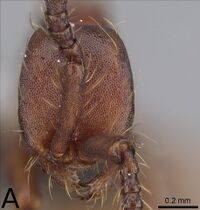Aenictus koloi
| Aenictus koloi | |
|---|---|

| |
| Scientific classification | |
| Kingdom: | Animalia |
| Phylum: | Arthropoda |
| Class: | Insecta |
| Order: | Hymenoptera |
| Family: | Formicidae |
| Subfamily: | Dorylinae |
| Genus: | Aenictus |
| Species group: | koloi |
| Species: | A. koloi |
| Binomial name | |
| Aenictus koloi Gomez, 2022 | |
Described from a hand collected series, from primary forest in Ivory Coast, of ground foraging workers. The only other collection is of 2 workers that were found in Ghana.
Identification
Gómez (2022) - A member of the Aenictus koloi species group. Aenictus koloi resembles Aenictus xegi in its overall aspect but it’s clearly smaller (HW<0.60 vs. HW>0.68), has less developed reticulation (sometimes becoming alutaceus over the head and femora), and the subpetiolar process is small, its size slightly larger than prora.
Keys including this Species
Distribution
Latitudinal Distribution Pattern
Latitudinal Range: 6° to 5.8°.
| North Temperate |
North Subtropical |
Tropical | South Subtropical |
South Temperate |
- Source: Gomez, 2022
Distribution based on Regional Taxon Lists
Afrotropical Region: Ghana, Ivory Coast (type locality).
Distribution based on AntMaps
Distribution based on AntWeb specimens
Check data from AntWeb
Countries Occupied
| Number of countries occupied by this species based on AntWiki Regional Taxon Lists. In general, fewer countries occupied indicates a narrower range, while more countries indicates a more widespread species. |

|
Estimated Abundance
| Relative abundance based on number of AntMaps records per species (this species within the purple bar). Fewer records (to the left) indicates a less abundant/encountered species while more records (to the right) indicates more abundant/encountered species. |

|
Biology
Castes
Known from the worker caste. Table of castes known for all Afrotropical Aenictus species.
Nomenclature
The following information is derived from Barry Bolton's Online Catalogue of the Ants of the World.
- koloi. Aenictus koloi Gómez, 2022: 36, figs. 1B, 20A-E, 21 (w.) IVORY COAST.
- Type-material: holotype worker, 24 paratype workers.
- Type-locality: holotype Ivory Coast: Montagnes Dist., Taï Research Centre (Taï Nat. Park), 200 m., 5.83293, -7.34251, 10.xi.2019 (K. Gómez & L. Kouakou); paratypes with same data.
- Type-depositories: BMNH (holotype); AFRC, CASC, FHGC, ISNB, KGPC, MHNG, MNHN, NHMB, RWAC, SAMC, YKPC (paratypes).
- [Note: 24 more paratypes stored in ethanol KGPC.]
- Distribution: Ghana, Ivory Coast.
Unless otherwise noted the text for the remainder of this section is reported from the publication that includes the original description.
Description
Worker
HL: 0.68 [0.63-0.72]; HW: 0.56 [0.53-0.59]; SL: 0.48 [0.45-0.51]; WL: 1.06 [0.95-1.13]; PL: 0.25 [0.23-0.26]; PH: 0.17 [0.16-0.20]; PPL: 0.20 [0.18-0.22]; PPH: 0.16 [0.13-0.19]; CS: 0.62 [0.58-0.65]; CI: 81 [78-84]; SIL: 70 [67-73]; SIW: 86 [81-89]; WL/HW: 188 [177-194]; PI: 142 [129-156]; PPI: 125 [111-149]; CSR: 112; (n=15).
With the characters defined for the koloi group and: funicular segments 1-8 subquadrate, the apical almost three times longer than wide. Head convex laterally, slightly widest at the middle, occipital line straight; ventrolateral margin reaching ventrally half the distance to the mandibular insertions.
Petiole with anterolateral and anterodorsal carina present, dorsolateral carina absent. In lateral view straight anterior face sloping approximately 45 degrees to a flat rounded dome, with a truncated vertical posterior face; postpetiole in lateral view from elliptical to subrectangular and rounded with almost vertical anterior and posterior faces. Subpetiolar process poorly developed, a quarter of ellipse with its vertical line facing forward, the whole subpetiolar process slightly larger than the prora. Sometimes a small lamella can be present.
Whole body including scape, funiculus and legs alutaceus to reticulated, deeper over propodeum, petiole and postpetiole. Gaster glassy smooth. Overall colour brown, with gaster clearly brighter yellowish brown. Metatibial gland yellowish, conspicuous.
Scattered yellowish white semierect to erect setae present everywhere; propodeum bare except adjacent to mesonotum and propodeal ridge, each with a pair of setae. Length of setae about petiole height on average.
Type Material
- Holotype worker, IVORY COAST: • Montagnes District, Taï Research Centre (Taï N. P.) 200m, 5.83293, -7.34251 10/11/2019. Hand collected (Gómez, K., Kouakou, L.). Primary Forest (1w), Foraging ground [KGCOL00551] The Natural History Museum.
- Paratype workers, • same data (3w) [KGCOL00552] CASC, (2w) [KGCOL00553] MHNG, (2w) [KGCOL00554] AFRC, (2w) [KGCOL00555] SAMC, (2w) [KGCOL00556] MNHN, (2w) [KGCOL00557] FHGC, (2w) [KGCOL00558] MNHB, (2w) [KGCOL00559] KGPC, (3w) [KGCOL00571] YKPC, (2w) [KGCOL02108] RBINS, (2w) [KGCOL02109] RWAC, (+20w eth) [KG04028] KGPC.
Etymology
The species name koloi is Latinized noun in the genitive case, dedicated to Professor Yeo Kolo, for his life dedication to West African ants and his invaluable help and support during my field trip to Taï Forest.

